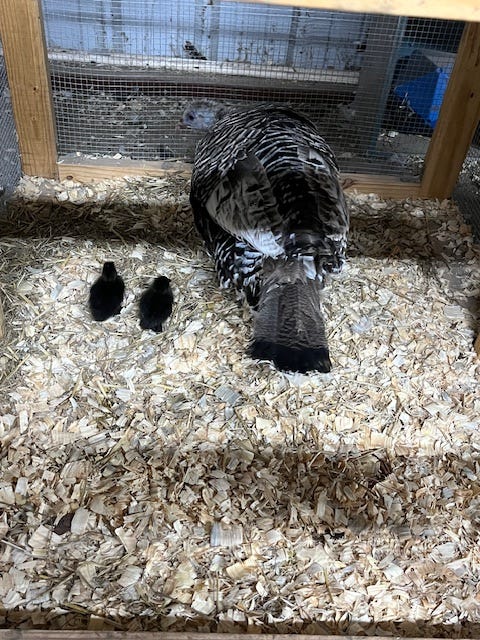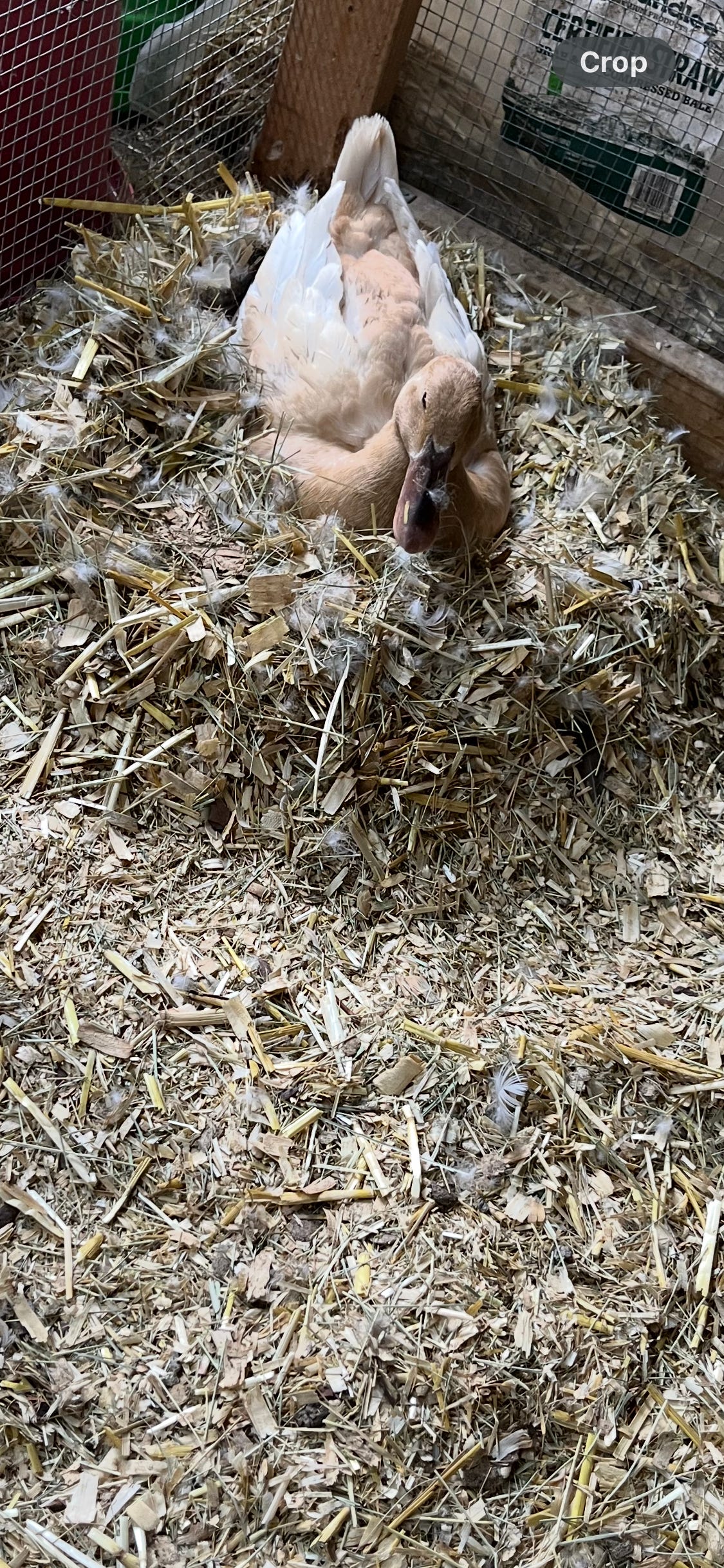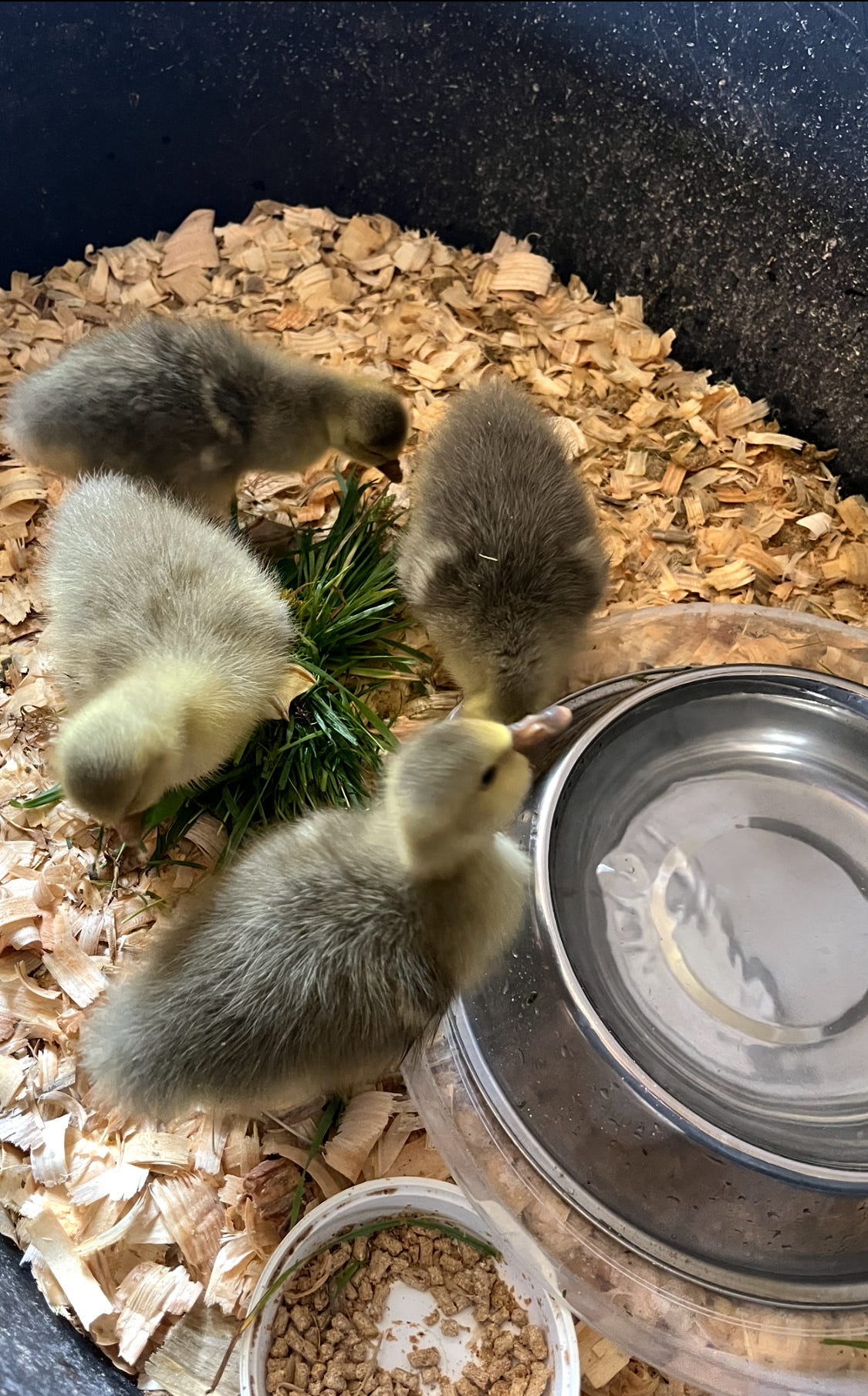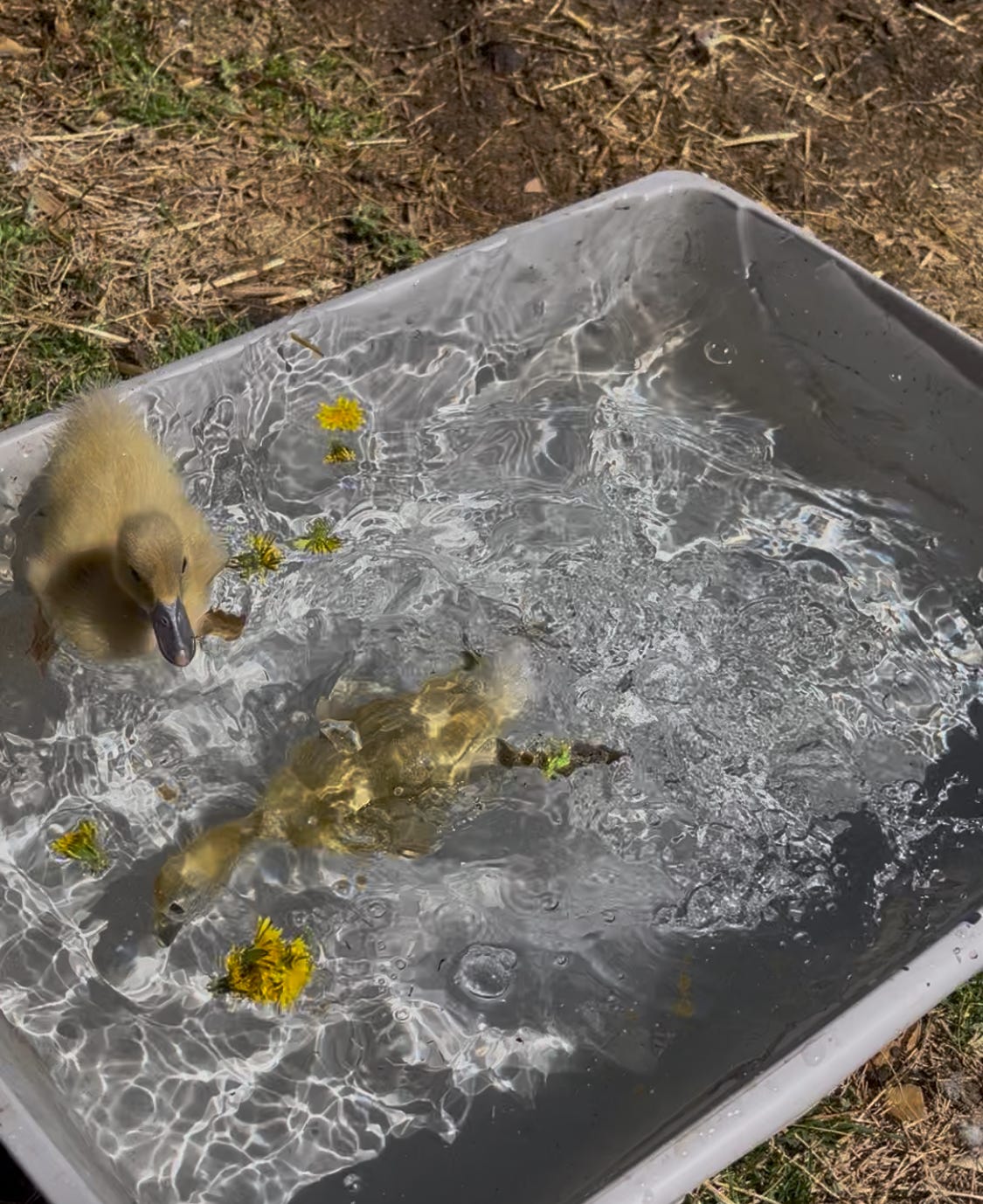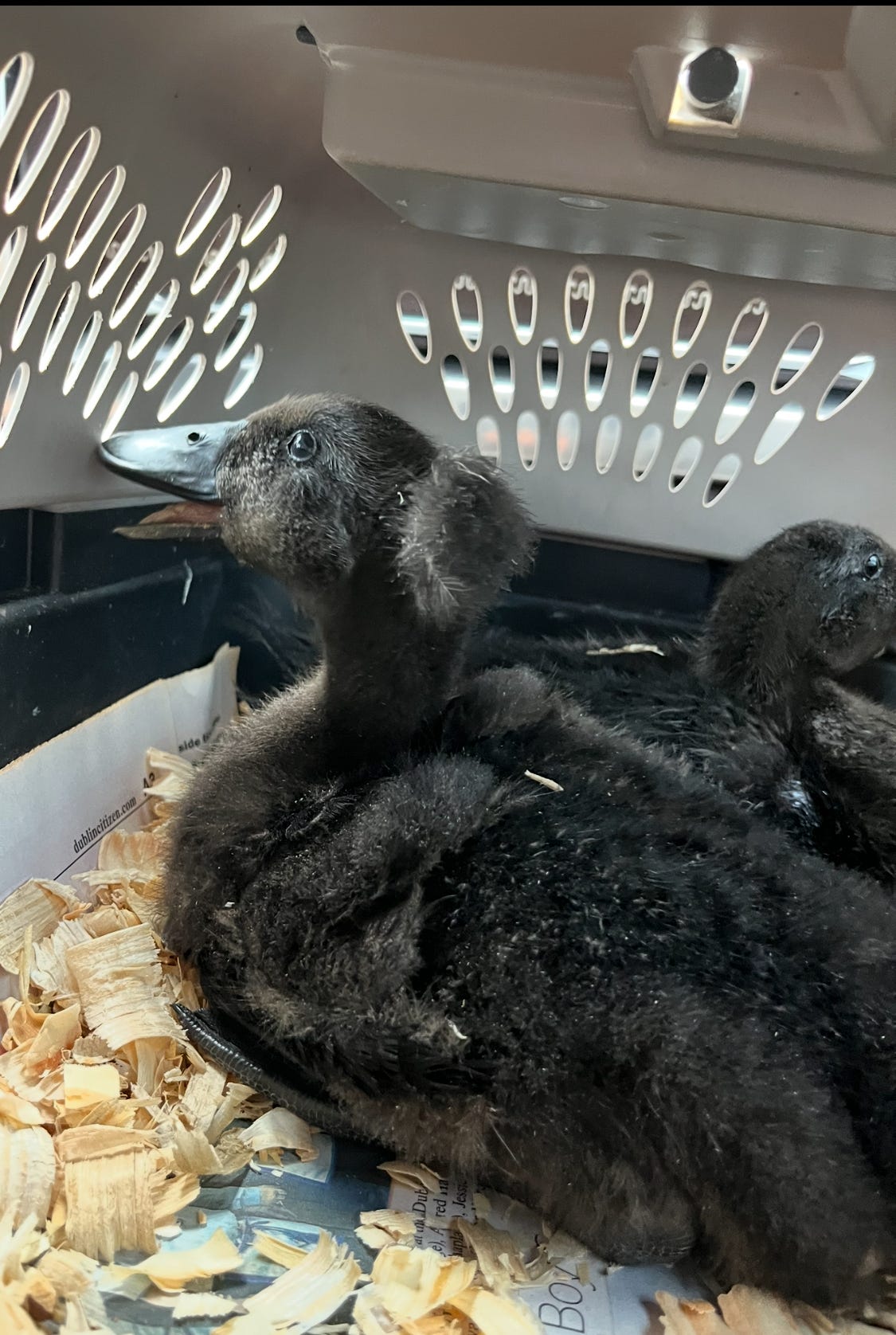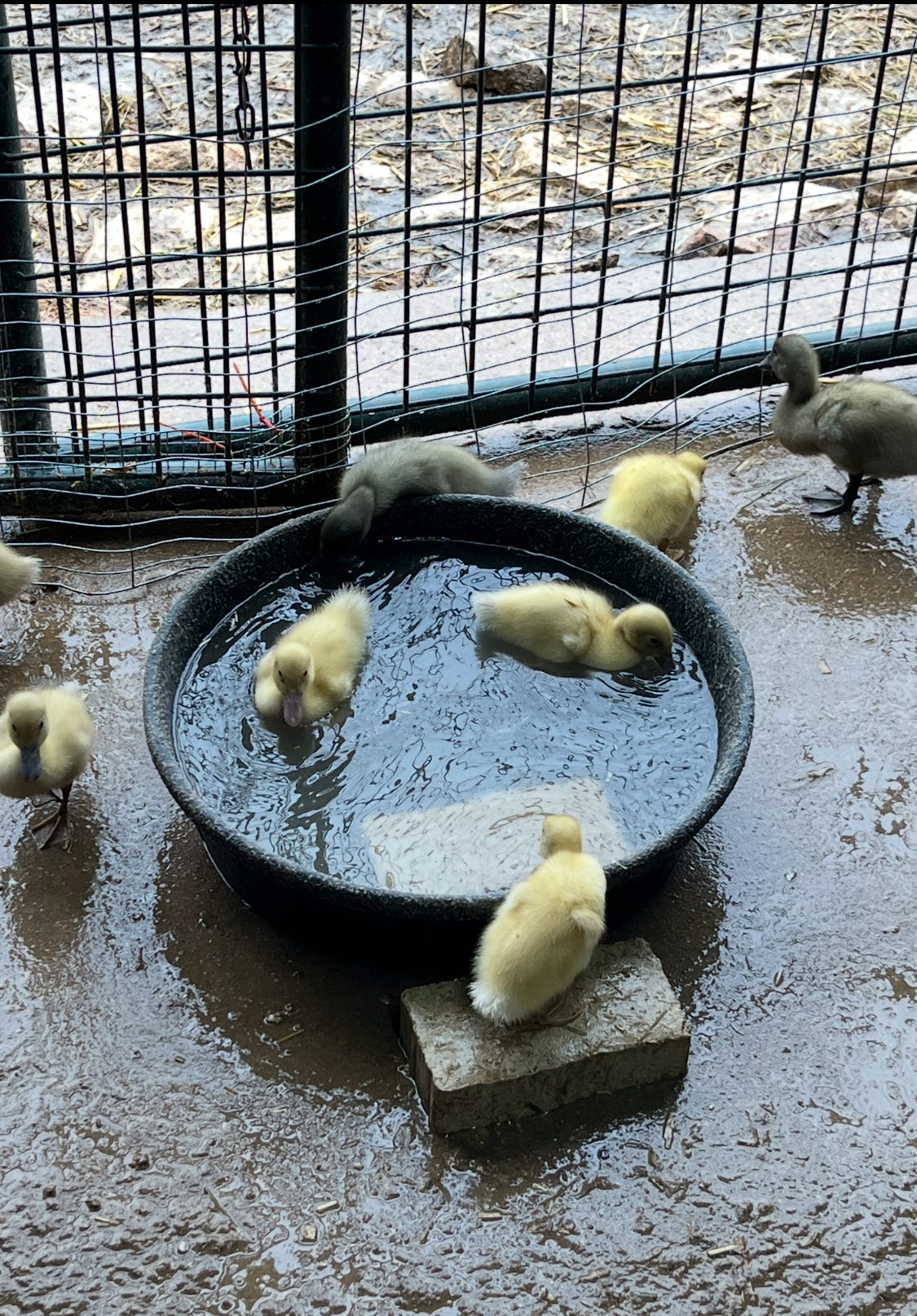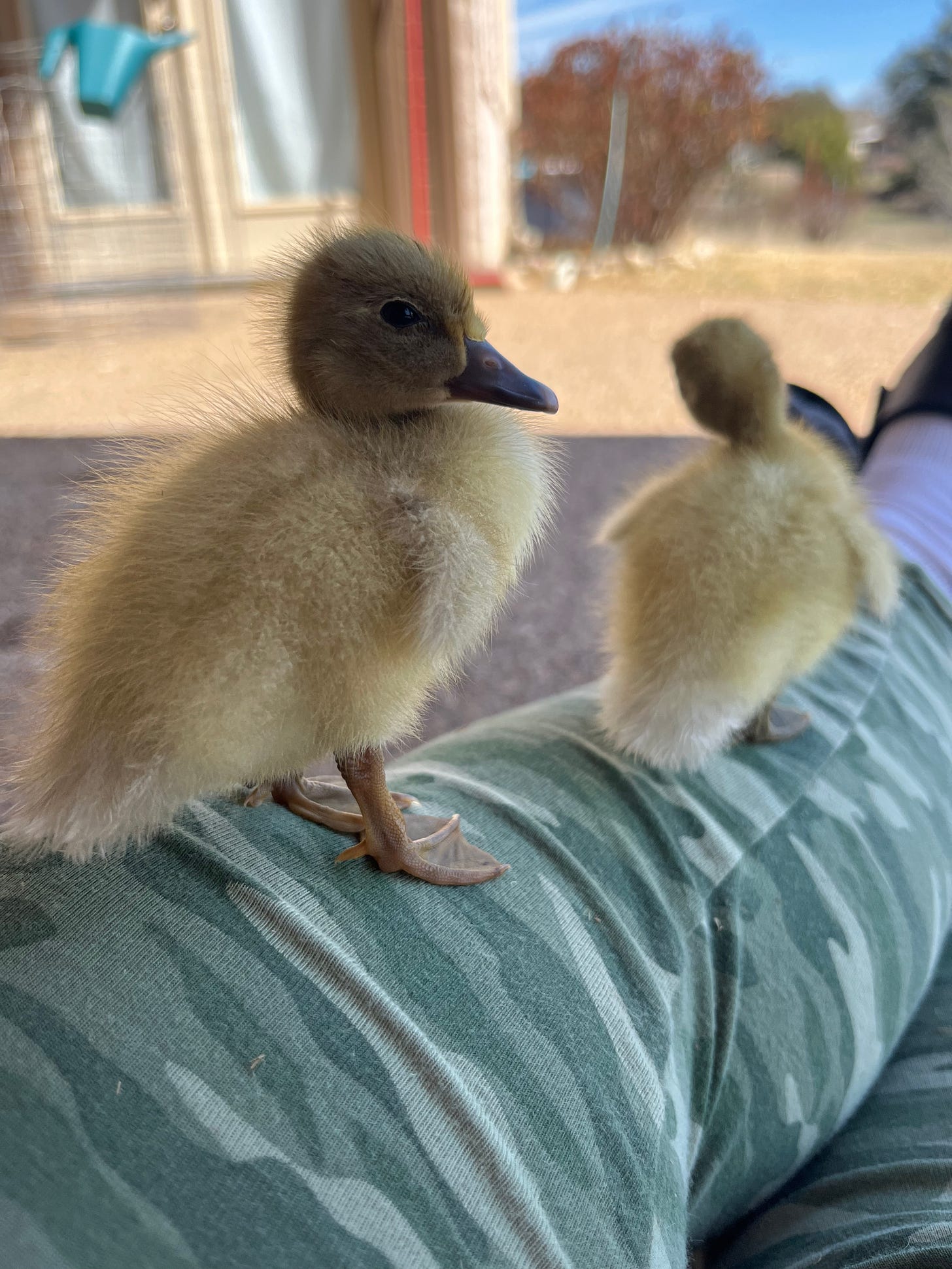Like a duckling to water
Oil glands & waterproofing
Anyone that’s hatched or bought ducklings has come across the internet warning: don’t let them swim until they’re fully feathered because momma has not coated them with her waterproofing feather oil. I guess this is contrary to the adage, like a duck(ling) to water.
Having hatched a few rounds of ducklings (naturally and artificially) and bought ducklings (shipped to me or locally from a store), I decided to test this out. I wanted a fun ‘research’ project with nothing really to prove, just observation and analysis. I would compare several groups of ducklings:
1) Store-bought ducklings. These are probably what most people would end up with, are artificially incubated and then shipped out, so no momma present. My sample for this group were the random ducklings I acquired to keep my lone duck company when I kept losing ducklings to a snake in the barn [since eliminated] and my Crested White ladies. The CWs are the best example because I couldn’t account for the age of the other ducklings at the time I got them (two Rouen rejects and two Pekins that had been discounted because they had been sitting there a few weeks).
2) Shipped hatchery ducklings. Probably the second way someone would get ducklings, artificially incubated so no mother present, either. Hatchery ducklings were how I started my flock with Cayugas, Pilgrim geese and my newest purchase, a Crested White male [I will HAVE my Crests!] and two Saxony males to add more body to my ducks.
3) Ducklings incubated and hatched in house. I’ve done this a few times, just to have ducklings, attempt sex-linked ducklings and as reference egg buddies for my goose or turkey eggs*.
4) Naturally incubated ducklings, turkey mom. I have some determined turkey hens that love hatching out ducks! This has happened twice now with my hen, Bob (she hatched out The Intrepid & Queen Anne’s Revenge-Cayugas and since, Buff Couscous). Another turkey hen, Maggie, is currently sitting on a mix of turkey and duck eggs.
5) Naturally incubated ducklings, duck mom. Finally! I haven’t had any of my ducks really commit to being broody [side tangent…is this a breed thing? Is it a husbandry thing, or a combo of those two?] until this spring (2025). I have tried tweaking the husbandry aspect since my Cayugas will attempt to lay and sit out in the pasture where it isn’t safe, so none have brooded successfully. My Buffs are consistent rockstars for laying eggs, but have never shown any interest in sitting [the Buff drakes, on the other hand are micromanagers and regular inspectors of all nests and eggs, to a fault. I haven’t figured this out yet]. The Crested ladies are also rockstars for eggs, but they haven’t all been fertilized consistently to even begin attempting brooding. One of them, Gullit, decided that a half-empty bag of shavings she had to jump into was a great place for a nest. I’m hoping they’re fertilized since I know exactly which duck they’re from, but despite a Blue Bib (Swedish) duckling I hatched from an unknown hen’s egg, they possibly aren’t fertilized. The only way this duckling was possible was from my Blue drake, Inter mating a Crested White.
This duckling however, had no crest, no matter how much I wanted it to [side tangent…how many ducklings are hatched without a crest from one non-crested parent?]. It would be interesting to see if this duckling carried any potential for crests, but being Bibbed (the Bib gene is very dominant and I only want solid colors in my ducks moving forward) it found a new flock.
This all changed this spring when I had four hens go broody! I had wanted to compare if the tendency to go broody was genetic or could be ‘taught’, depending on how the ducks themselves were hatched. The first one to Say Yes to the Nest was Maggie, my Royal Palm hen. She was artificially hatched by me in April 2024 and decided to sit on some of her eggs and some of my Cayuga Leganés that she kept adding to the same nest. Her nest was successfully located in a corner of my horse’s stall with flake shavings.
The ducks were the next to sit, Buff Couscous chose a mixed straw/hay/shavings tall nest inside the mesh box I put all my littles in to keep them safe. Cous had been hatched by Bob and spent time in that box growing up.
My two Lilac Cayugas chose to nest together inside a large plastic kennel with mostly straw and some hay from the bales stored nearby. Fiorentina (5/24) is less committed than Raja (7/24) because she will leave the nest for most of the day and lately even at night Raja has not allowed her to stay on the nest. These Lilacs were incubated and hatched by me as part of my sex-linked duckling project.
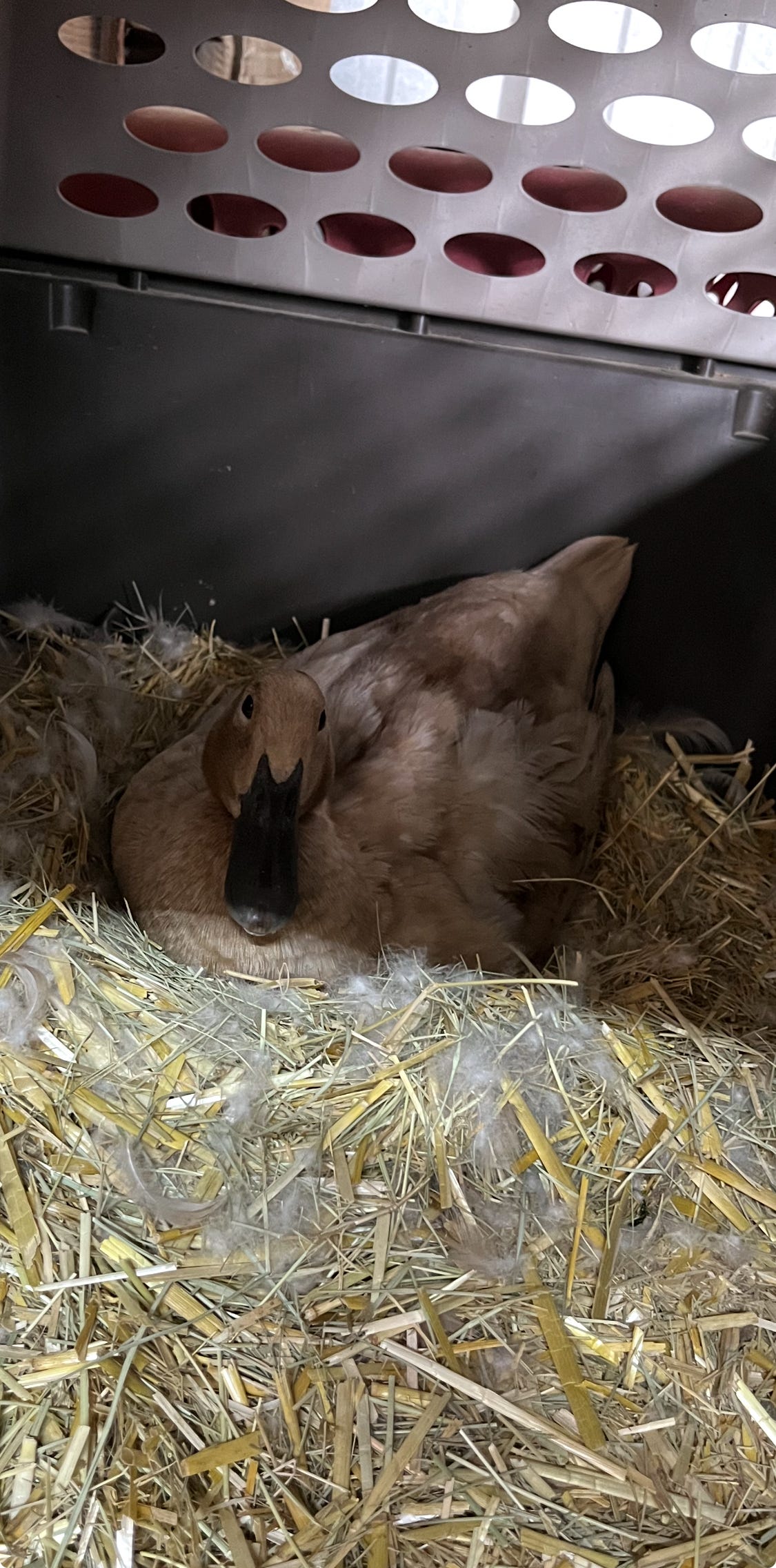
So far there seems to be an age component to the broodiness - young mothers are perhaps less experienced, but more idealistic? I do have other eggs being laid: Leganés, the Cresteds and Fio in the barn, turkeys Bill & Bob in the pasture [unless I find these eggs fast, they get eaten so neither has collected enough to sit] and my Pilgrim goose, Veronica. The geese usually share a stall with the ‘Darkwing Ducks’ (my nickname for the ducks I will need for Black Crested ducks: Black, Blue and Lilac). This year, though, the geese’s second year of laying, they have been both more productive and more protective of the nest, so the ducks were moved out to gen pop. I have had to do a ‘fun’ dance of adding goose and duck eggs to already running incubators (staggered hatching) to account for fertilized eggs not being wasted. So far I’ve hatched 3 ganders (out of her first 7 eggs) and another 4 from the next 7 are set to hatch end of this month. She also has another 6 in the nest currently in some stage of development since she sits the nest, but only during the night. Eek - not the best for Pilgrim goose management, but I wanted to see if she would go broody. That makes 20 eggs, which should be half of what she’s capable of laying, but we’ll just have to see what happens. Pilgrims are threatened and notoriously have low fertility.
Waterproofing of feathers
Poultry groom themselves by stimulating the oil gland [the Uropygial gland] near the base of their tail and spreading the sebum [oily/waxy secretion] on their feathers. The slang term for using this part in the kitchen is the ‘Pope’s nose’ and is some people’s favorite part and hated by others (I’m in this group). The sebum provides shine while repelling dust, parasites and moisture. Turkeys round out their grooming by dust bathing and spending time preening: fluffing up their feathers, removing damaged feathers, picking at pores or specific feathers and running their beak down feathers to clean them. Waterfowl will bathe in water then finish grooming out of the water by stimulating the gland then using their bill and head to rub the oil on their back, flicking their tails and wings to fully dry and using their bill to either wet or dry areas like their belly and chest. Personally, I think that water is key to stimulating waterfowl to groom, regardless of how they’re hatched and raised. In grown ducks that don’t have access to deep, clean water to bathe, the gland can stop being useful. These birds have an unkempt and greasy look to them that leads to the name of this condition, ‘Wet Feather’ disease. The treatment is to offer deep, clean water and quality nutrition like for a molting bird. I also think an important part of the stimulation to groom has to mimic ponds in the wild: deep, cold water and warm, sunny rocks nearby. I try to stage this with my adult birds as well as my babies. The waterfowl also enjoy the splashy noises made by running water as well as things that float in the water, especially if they are edible! What starts as clean water inevitably and very quickly becomes the opposite if you have ducks, so even though they love trolling the bottom for edible things that sink (grapes!!!), putting food in the water makes it nasty fast.
All of my babies begin with their bills dipped in vitamin water and I have to visibly see them swallow it. Wetted pellets topped with power starter (flaxseed, chia, yeast and seaweed) are offered free choice all the time. Water is offered in progressively larger dishes with Kaytee Bird Greens floating in it and if available, fresh greens from my yard (grasses, dandelions, sourgrass - never anything with chemical treatments). The Bird Greens are chopped very small since it’s for pet birds, but the sight of them floating stimulates curiosity at first - they peck at the water - followed by enjoying the taste. Anything from the yard needs to be shredded smaller, but the idea is also that the ducks use the water to help them eat the plants. My goslings are the only ones that will attack entire blades of floating grass very happily, their serrated bills are like a tiny sawmill and they love chewing on plants.
So perhaps it’s this water dish with floaties setup that lends itself to my situation, but I have not been able to keep my baby birds out of the water. For turkeys this is hardly applicable, they are very dainty around the water once they actually figure out how to drink it! As adults, turkeys prefer shallow, wide dishes of water to cool their feet in when it’s hot or shallow running water to walk in. The waterfowl, on the other hand, is a constant changing of water to fresh because of the way they eat by wetting their food and constantly in & out of the water dish. I have seen setups of water drinkers (I am not a fan of these, perhaps because I don’t keep chickens, which are the only species these are useful for), water dishes on grates and paint trays, water slides, etc. I can somewhat contain the mess in the brooder by putting water dishes inside other larger shallow dishes until they can free range - which conveniently teaches them to step in & out of the pool as adults. I fill up a cat litter box with water for them to swim in when they’re one week old with floaties, in full sun for five minutes and warm rocks to dry off in nearby. This activity runs from acceptable to absolute joy - usually expressed by the Cayugas acting like submarines.
In the barn there are separate containers and areas for drinking vs. swimming water. No ‘swimming’ water is allowed inside the barn or overnight because of the wide swath of mess the ducks make continuously during the night. Drinking water is in buckets that are short enough to drink from but too narrow to ‘get in’ and will still have a puddle of mess around them every morning.
I have noticed water preferences as adults that may factor in. These are my experiences and not critical or reflective of entire ‘breeds’ - do your own research and let me know what you find.
Cayugas: live in the water as ducklings, very active ducklings, less so as adults.
Buffs: ambivalent about water both as ducklings and adults, they seem to like walking great distances.
Crested Whites: ambivalent as ducklings, but as adults they love bathing, being sprayed and sprinkled. They come running whenever I have a hose! Not as active as the others, but more personable and curious.
Saxony: I currently only have four-week old males, who have brooded with a CW male from the hatchery and two older Splash ducks I hatched here. They were ambivalent until being moved out to the barn and the addition of the Splashes. Probably because of access and imitating them, they are in the water a lot during the day swimming actively or sometimes just sitting inside the water (they have several depths and sizes of water pools to chose from).
Pilgrim geese: Other than my parent pair I raised inside then moved to the barn, I haven’t kept goslings long enough to observe. The goslings I brood inside will step and stand in their water dishes, but aren’t interested in swimming as such or deep water. As adults, the geese will bathe a couple of times a day, mate in cold, deep water and prefer water that is fresh and clean (that doesn’t last long with ducks, my geese will usually stand in the pool while it’s filling and keep the ducks away until they’re finished bathing). The geese don’t swim per se, they are very intentional and consistent with bathing - dunking their neck in the water and splashing it down their back. If it’s very hot out, the geese will float in the water without being very active to stay cool. As juveniles, I felt it was important because of the heat and for cleanliness/grooming to dunk my geese in the pool, they wouldn’t climb in on their own like the ducks. After two or three times of this, they would do it on their own, but this was like kick starting stimulating the gland and them cleaning their feathers.
I shelved this article for about a month while I waited for the various eggs to hatch, under hens or inside the incubator. My reasoning was to be able to compare well the different groups of ducklings and because I had recently gotten discouraged about writing at all. I had reached out to a popular bird image site, offering pictures of rare colored ducks, from hatch to adulthood and the visible results of what the duck color calculator had predicted. Despite acknowledging that he “doesn’t know anything about duck genetics”, he said I was wrong and my duck images “weren’t a breed” and wouldn’t be posted on his site. This kind of doubling down on ignorance is not useful to anyone. I strive to learn, not only through research but experience as well and then share what I’ve learned and experienced with any others that also want to know or learn - especially young students. I hope this is evident in my other articles, about agriculture and our food supply, duck color genetics and volunteering with high schoolers. So I decided to finish this article and keep writing [I’m currently working on compiling data on hatching Crested ducklings and comparing it to the internet lore that keeps getting circulated, discussing trait selection and mutations that become selected as a breed standard - think Manx cats or Araucana ‘rumpless’ chickens].
Updates on the duckling groups:
Store-bought ducklings. I haven’t done this for awhile, except a few weeks ago I stumbled upon a Crested Cayuga duckling for sale on Craigslist and jumped on it. The breeder does not have any Crested ducks and was confused as to ‘how that happened’.
These ducklings (I bought a non Crested sibling as well, for company even though they quickly became a flock with my three weeks older Buff ducklings) were artificially incubated and brooded in a plastic tub in her garage. Being five of them and already over three weeks old, there wasn’t much room left in the brooder and they kept overturning their food/water dishes. Here their setup was a shavings filled box [closed at night but open all day] with a fenced area around it that included food and the litter box full of water. They were very shy and flighty (still kind of are), but having the Buff ducklings show them the ropes really helped. At first they wouldn’t eat my food and would only drink from the edge of the litter box. Eventually they did learn to eat the grass clippings I would put in the box before filling it every morning and would get in to swim. Key factors to consider for this group: age (it’s easier to teach younger ducklings to swim) and husbandry: what do they have access to after hatching, while brooding and then as they get bigger and begin to free range?
Hatchery ducklings: My CW male and two Saxonys are definitely latecomers to the swim party. They weren’t as enthusiastic as my other ducklings have been, but with age/size/time they have actually come to enjoy being sprinkled on the lawn, sprayed with the hose when it’s hot and my Saxonys will climb in to troughs to swim. Triple digit weather has helped them enjoy the water more than as ducklings and my CW male does like being sprayed, but swimming not as much.
In-house hatchlings: I have my brooding strategy well defined by now and my ducklings seem to all enjoy progressively bigger water to swim in. The last step before free ranging is the fenced pen with a litter box, one paver on the outside and one on the inside, which teaches them how to get in and out using rocks. The troughs and pools I have for my birds have rocks inside and outside like this, so this teaches them how to get in and out while little.
(Yes, I know). I skipped ahead to duck-mom hatchlings because I have less to say about these guys. After being broody for such a long time, my duck moms love to bathe and splash, and the ducklings follow along. For my setup (water dishes), quite a few ducklings got stepped on regularly by their mom, but no one was truly injured. In the wild, I’m sure moms use a beach type entry and exit from the water, but I don’t have that here.
Turkey-mom ducklings: This has always been a fascinating topic for me to explore, thanks to my industrious turkey hens that love brooding. I had been monitoring and candling the eggs and Maggie was down to one duck egg that quit late in the game before hatching. Raja was sitting on a dozen! duck eggs, so I borrowed one of hers and replaced the bad egg for Maggie. She successfully hatched out a Buff duckling and was very protective of it. That went well for about a week, when I let them start ranging. Maggie being a turkey walked extensively (one long legged turkey stride was about a million for duckling) and I was concerned that duckling wasn’t eating or drinking enough - too much time spent walking! The duckling was also very confused, it would avoid the other ducklings and would only respond to turkey calls - basically, it didn’t know how to be a duck. So I moved it inside the fenced area with the other ducklings and Raja, Maggie on the outside but within eyesight and hearing. It took a few days to adjust to being a duckling, then it was not distinguishable from the others. The times Bob has hatched ducklings, I had left them all enclosed together for much longer because it was winter, so this was the first time I could see the too much turkey trot issue as well as not knowing how to be a duck.
So, after all that, I decided that the waterproofing of duckling feathers is not what is key. Once they dry off after hatching, they can get wet and do have some buoyancy. What ‘mom’ provides them, whether turkey, duck, or human, is safety around water. This includes entry and exit points as well as avoiding deep water without a respite. In the wild, this makes sense as mom and ducklings use a beach to get in and out and avoid deep water where snapping turtles and fish lurk under the water. Once they begin bathing, they are stimulated to dry off and groom themselves, activating their own oil glands.
So don’t be afraid to let your ducklings splash, swim and explore, as long as they are safe and have a warm area to dry off in afterwards!
Footnotes
*A friend with a lot of experience taught me to add ‘reference duck eggs’ to my goose hatches. This means adding some duck eggs in with whatever other eggs you’re incubating. The idea is that if other eggs develop and not duck = duck eggs aren’t fertilized. Duck eggs develop and others don’t = other eggs aren’t fertilized. No eggs develop = incubator is the problem. Ducks are very hardy and have the same time to hatch as the bigger birds at 28+ days (chickens wouldn’t work, being 21 days to hatch and delicate as chicks). The other benefit is that the ducklings that hatch are buddies for the others, in case you only get one to hatch. Goslings need buddies since they are very social and highly intelligent. Turkeys greatly benefit from other chicks demonstrating how to eat and drink (yes, turkeys are special - not dumb, but definitely high maintenance compared to the waterfowl!). This is also beneficial once they start moving on to new flocks, no one goes alone.




